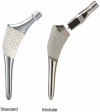Effect of symmetrical restoration for the migration of uncemented total hip arthroplasty: a randomized RSA study with 75 patients and 5-year follow-up
- PMID: 32552711
- PMCID: PMC7301498
- DOI: 10.1186/s13018-020-01736-0
Effect of symmetrical restoration for the migration of uncemented total hip arthroplasty: a randomized RSA study with 75 patients and 5-year follow-up
Abstract
Background: Inferior placement of a femoral stem is predictive for early loosening and failure, but does restoration of the original hip anatomy benefit the function and survival of a total hip replacement?
Methods: Seventy-five patients with primary unilateral hip osteoarthritis operated with an uncemented anatomical stem were randomized for either standard or modular stems. We used 50 ABG II stems with modular necks and 25 standard stems (control group). We measured the symmetry in hip anatomy between healthy and operated side. The anatomical restoration variables were anteversion, global offset, and femoral offset/acetabular offset (FO/AO) quota. We performed measurements using a CT-based 3D templating and measuring software. Migratory behavior of the stems was then measured postoperatively with repeated radiostereometry (RSA) examinations over 5 years.
Results: Both stem types showed an early (within 3 months) good stabilization after an initial slight rotation into retroversion and subsidence. There were no significant differences in RSA migration between modular and standard stems. Postoperative anteversion and FO/AO quota had no impact on stem migration. The standard stem tended to result in insufficient global offset (GO), whereas the modular stem did not.
Conclusions: The modular stem gave good symmetrical anatomical restoration and, like the standard version, a benign migratory behavior. Anteversion, GO, and FO/AO quota had no significant impact on stem migration. It therefore seems to be of no importance whether we choose a modular or a standard stem with regard to postoperative stem migration for this stem type. We overestimated the effect anatomical parameters have on stem movement; hence, we believe the study to be underpowered.
Trial registration: ClinicalTrials.gov identifier: NCT01512550. Registered 19 January 2012-retrospectively registered.
Keywords: 3D-CT; Anatomical restoration; RSA; Radiostereometry; THA; THR.
Conflict of interest statement
Dr. S. Kiernan and Dr. G. Flivik have both served as advisory consultants for Ortoma AB during software development. The other authors declare that they have no competing interests.
Figures






Similar articles
-
Early stabilization of the uncemented Symax hip stem in a 2-year RSA study.Acta Orthop. 2020 Apr;91(2):159-164. doi: 10.1080/17453674.2019.1709956. Epub 2020 Jan 13. Acta Orthop. 2020. PMID: 31928120 Free PMC article. Clinical Trial.
-
Migration of the uncemented Echo Bi-Metric and Bi-Metric THA stems: a randomized controlled RSA study involving 62 patients with 24-month follow-up.Acta Orthop. 2020 Dec;91(6):693-698. doi: 10.1080/17453674.2020.1802682. Epub 2020 Aug 6. Acta Orthop. 2020. PMID: 32757687 Free PMC article. Clinical Trial.
-
Early Subsidence Predicts Failure of a Cemented Femoral Stem With Minor Design Changes.Clin Orthop Relat Res. 2016 Oct;474(10):2221-9. doi: 10.1007/s11999-016-4884-2. Clin Orthop Relat Res. 2016. PMID: 27188836 Free PMC article.
-
Femoral offset: anatomical concept, definition, assessment, implications for preoperative templating and hip arthroplasty.Orthop Traumatol Surg Res. 2009 May;95(3):210-9. doi: 10.1016/j.otsr.2009.03.010. Epub 2009 May 6. Orthop Traumatol Surg Res. 2009. PMID: 19423418 Review.
-
Comparative outcomes between collared versus collarless and short versus long stem of direct anterior approach total hip arthroplasty: a systematic review and indirect meta-analysis.Eur J Orthop Surg Traumatol. 2019 Dec;29(8):1693-1704. doi: 10.1007/s00590-019-02516-1. Epub 2019 Jul 30. Eur J Orthop Surg Traumatol. 2019. PMID: 31363848
Cited by
-
Pre- and postoperative offset and femoral neck version measurements and validation using 3D computed tomography in total hip arthroplasty.Acta Radiol Open. 2020 Oct 8;9(10):2058460120964911. doi: 10.1177/2058460120964911. eCollection 2020 Oct. Acta Radiol Open. 2020. PMID: 33101707 Free PMC article.
-
Unexpected varus deformity and concomitant metal ion release and MRI findings of modular-neck hip stems: descriptive RSA study in 75 hips with 8 years' follow-up.Acta Orthop. 2021 Feb;92(1):67-73. doi: 10.1080/17453674.2020.1853387. Epub 2020 Dec 10. Acta Orthop. 2021. PMID: 33297800 Free PMC article.
-
Comparison between model-based RSA and an AI-based CT-RSA: an accuracy study of 30 patients.Acta Orthop. 2024 Jan 29;95:39-46. doi: 10.2340/17453674.2024.35749. Acta Orthop. 2024. PMID: 38284788 Free PMC article.
-
Anterolateral approach may be superior to posterolateral approach in controlling postoperative lower limb discrepancy in primary total hip arthroplasty: A single-center, retrospective cohort study.Jt Dis Relat Surg. 2023;34(1):32-41. doi: 10.52312/jdrs.2022.763. Epub 2022 Nov 18. Jt Dis Relat Surg. 2023. PMID: 36700261 Free PMC article.
References
-
- Cassidy KA, Noticewala MS, Macaulay W, et al. Effect of femoral offset on pain and function after total hip arthroplasty. J Arthroplast 2012; 27: 1863-1869. 2012/07/20. DOI: S0883-5403(12)00310-5; 10.1016/j.arth.2012.05.001 [doi]. - PubMed
Publication types
MeSH terms
Associated data
LinkOut - more resources
Full Text Sources
Medical

